We have a commitment to evaluation and to sharing the evidence that what we do makes a difference. School of Psychology researchers from the Australian National University are currently evaluating the impact of neighbour groups and our work. The evaluation information below is drawn from our own evaluation conducted at the end of 2019 which explores Neighbourhood Groups, their reach and outcomes, and the experiences of group organisers (“Connectors”).
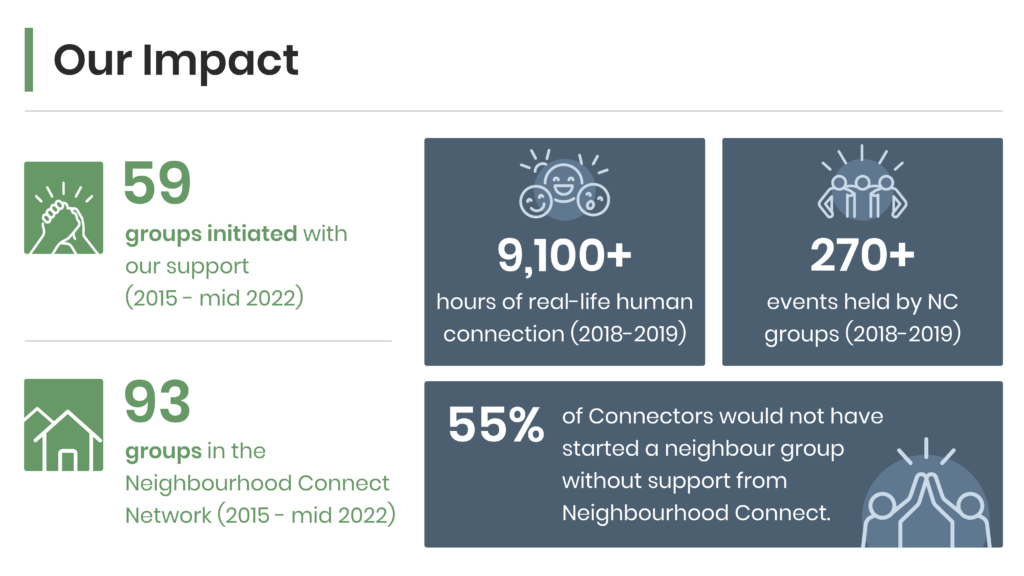
- In 2021-22 an independent evaluation of the Neighbourhood Connect Let’s Get Neighbourly program was conducted by researchers at the Australian National University (ANU).
Main findings:
- Major themes emerging from all participants in the evaluation were that neighbour groups brought a sense of ‘cohesion’, ‘unity’ and ‘support’ to their community, while also providing them personally with a greater sense of ‘confidence’ and ‘connection’.
- Following the launch of their neighbourhood group, Connectors (group leaders) reported having increased their number of neighbourhood connections by 247%.
These benefits were further reflected in a significant increase in their overall level of satisfaction with being a part of the community and a 28.5% increase in engagement with local businesses. - Neighbours in these groups and events scored above the population mean on satisfaction with neighbourhood safety. Participants increased their number of neighbourhood connections by 327%.
- Most importantly, Connectors overwhelmingly reported that they would not have gone ahead with forming a neighbourhood group if they had not participated in the Let’s Get Neighbourly program. This highlights the importance of Neighbourhood Connect’s work in facilitating and supporting these neighbourhood groups.
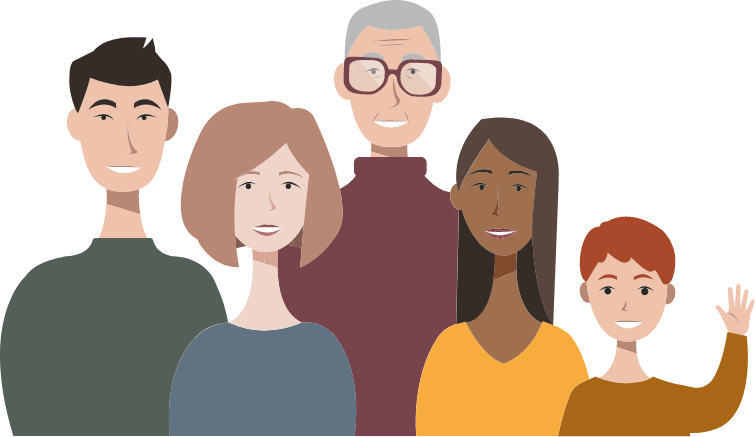
100%
of connectors reported having stronger connections, friendships and relationships among neighbours. Connectors have higher sense of community, life satisfaction and social support than reported in large scale Australian studies.
612%
increase in connections with
neighbours.
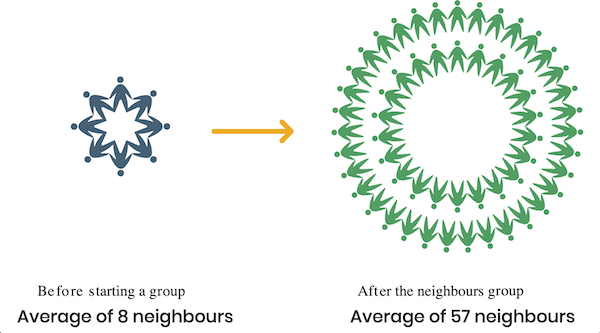
“People have been getting to know each other better and that has led to sharing and a sense of belonging. I feel I know these people so much better now.
There’s a nice community vibe around the neighbourhood. Kids have got to know each other better – they’ve made friends. We’ve activated the community about local issues. I feel it’s easy now to ask for help, such as feeding my cat. People are happy to help.”
– Maureen , Hilton Neighbours Group, WA
The Neighbourhood Connect Project
Outcomes
Number of Neighbour Groups
By mid 2021, Neighbourhood Connect had helped 47 neighbour groups get started. A further 29 groups were part of the Neighbourhood Connect Network, bringing the total to 76 groups.
Where is the project being taken up?
The majority of new neighbourhood groups have been in Victoria, followed by Western Australia. The vast majority are in urban areas.
Participation in Neighbourhood Connect Groups
Groups led by the 14 Connectors interviewed had between 17 and 206 members, with the number of people coming along to face-to-face events ranging from 15 to 80 per group.
Each neighbourhood group has its own flavour, shaped by its members. Most groups have a regular social gathering at a local venue, park or home. This ranges from every 3 weeks to every quarter.
What has happened as a result of having Neighbour Groups?
Neighbours build a strong sense of community and reduce loneliness through a wide range of activities:
Creating opportunities for social connection:
- Sharing conversation and food at local restaurants, parks (barbecues) and homes. Most keep it simple (buy your own or bring a plate), others have progressive dinners and cake bake offs! Some add games or a talk to the mix.
- Groups have larger activities from time to time, such as end of year celebrations, parties, outdoor movies, Easter egg hunts, treasure hunts, cricket. Using the skills of local members, there is sometimes live music and face-painting.
- Some groups include a walking group (with or without dogs), Zumba classes, aqua aerobics and social golf.
- One group has its own choir.
- Neighbours go together for live music, talks, trivia, wineries, shows and movies.
Lending a helping hand to others:
- Some groups improve the neighbourhood by having clean ups and then socialising over, for example, strawberries and champagne. Some garden and plant together.
- One group adds an element of helping the disadvantaged by having everyone bring along coats, blankets or other things to donate to charity.
- The email list or Facebook group is used for sharing and asking for help or recommendations.
Improving engagement with their local community:
- A couple groups have gained money through council or crowd funding to hold an event or improve their park.
- Some take action on a local issue.
What does this all mean?
Survey Findings
The survey was designed to uncover impacts on Connectors who have been having regular activities with neighbours for over 6 months. Of the 14 Connectors interviewed, 3 were excluded from the survey because they have not had regular gatherings for over 6 months. 11 Connectors completed the survey. While this number is small, the comparison data comes from large scale studies.
Greater sense of belonging and trust
The Connector’s average score on satisfaction with feeling part of the community was 8.39, which compares favourably with the result of 6.63 from the nationwide HILDA study in 2013 and 6.75 in data from sixty four Melbourne Metropolitan Councils in 2018.
91% have greater trust in their neighbours since starting a neighbour group.
Improved life satisfaction, happiness and wellbeing
The Connector’s average score on life satisfaction was 8.64, which compares favourable with 7.6 from the Australian Bureau of Statistics General Social Survey and 7.9 from the HILDA study.
Number of neighbours known
Before starting a neighbour group, Connectors knew an average of 8 neighbours and they now know an average of 57. Importantly, they have made an average of 6.5 new friends each. 100% of Connectors chat with their neighbours often or very often.

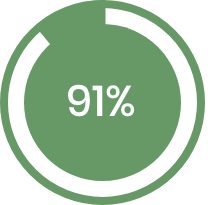
Happier and have greater wellbeing
91% reported that since starting their neighbour group they are happier and have greater wellbeing.
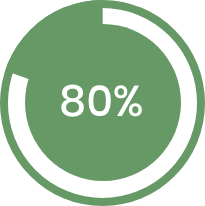
Reduction of loneliness
Of those who experience loneliness, 80% experience less since starting a neighbour group. While 17% of Australians in the HILDA study often felt lonely , none of the Connectors felt this.

Improved social support
80% of Connectors help their neighbours at least monthly (some daily or weekly). 40% receive help weekly, 50% monthly and 10% every few months. While 9.5% of Australians lack social support , none of the Connectors lacked social support.

Greater involvement in local issues
82% report greater awareness of local issues and 73% report greater involvement in local issues compared to before they started a neighbour group.
45% now use local businesses and services more.
The Connectors
Groups have between 1 and 7 Connectors (average of 3), with Connectors much preferring not to do the role solo.
Number of neighbours known
- 82% are female and 45% were born overseas
- They have lived in their areas between 4 and 30 years (average 11)
- 36% are aged 35-44, 36% aged 45-59, 27% aged 60-74
- 45% are working full time, 45% part-time and 10% retired
What concerns do Connectors have about starting a group?
42% had no reservations. Those that did were concerned about how to actually go about it (they found the resources we provided helped), the time commitment, whether people would come and whether others would help organise events.
What are the good things that have come out of it for Connectors?
Meeting great people and increasing connections, community and friendships are the main things Connectors gain from leading a neighbour group. Getting help when you need it is also an important outcome. Connectors find it satisfying to make things happen in their neighbourhood and enjoy the appreciation from neighbours.
Our approach
The Neighbourhood Connect approach of creating informal ongoing groups of neighbours is highly effective in:

Creating social capital and a sense of community, belonging and trust
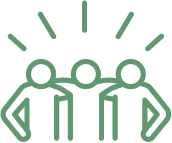
Increasing social support (the result of people helping one another)

Improving happiness and wellbeing

Increasing engagement in the local community and in local issues

Decreasing loneliness and social isolation

Increased utilisation of local businesses
